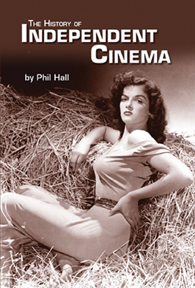(BearManor Media, 320 pages, $21.95)
By Phil Hall
 The last decades have narrowed our thinking about the term “independent film.” Today it means the upsurge in independently financed moviemaking that followed (take your pick) She’s Gotta Have It, Sex, Lies, and Video-tape or Reservoir Dogs. Often it evokes a directorial mindset, or a predilection for outré or shocking subject matter, and sometimes it’s deployed long after a formerly independent director has embraced the studio method.
The last decades have narrowed our thinking about the term “independent film.” Today it means the upsurge in independently financed moviemaking that followed (take your pick) She’s Gotta Have It, Sex, Lies, and Video-tape or Reservoir Dogs. Often it evokes a directorial mindset, or a predilection for outré or shocking subject matter, and sometimes it’s deployed long after a formerly independent director has embraced the studio method.
Phil Hall’s definition of independent cinema is more wide-ranging, starting not with the rise of Miramax but at the birth of cinema itself. Throughout his survey, one is repeatedly struck by how many movies were independently produced: Griffith’s Intolerance, entire specialist markets ranging from “race movies” to Yiddish-language productions, and even James Cameron’s first Terminator. And that’s to say nothing of phenomena like ’60s underground cinema; the actor-led post-war independent outfits of Jimmy Stewart, Kirk Douglas and Burt Lancaster; and the UCLA uprising of 1970s African-American filmmakers.
Directors also demonstrated independence, with Ida Lupino serving as a role model for women directors, and John Cassavetes inspiring wannabe filmmakers even today. John Waters, George Romero, John Carpenter, Joan Micklin Silver and Joe Dante all preceded the Lees and Soderberghs by decades. Somehow Hall includes them all in this dizzyingly detailed, authoritative account. One is repeatedly caught up short by hitherto unfamiliar fields of endeavor, lost movements, forgotten classics and weird specialty markets. He may have cast his net a tad too widely but in every unlit corner of this book, there is another splendid lost factoid or misbegotten masterpiece.
Review written by John Patterson.